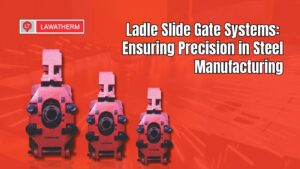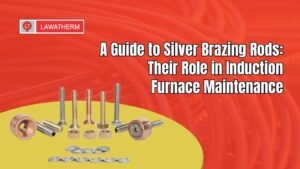In any steel manufacturing process, your furnace is the heart of the operation. Its performance directly affects output, cost, and safety. Every unplanned breakdown delays production, increases overhead, and strains your maintenance crew. That’s where preventive maintenance makes a difference.
You can’t afford to wait for something to fail. The right actions, taken at the right time, keep your induction furnace components running longer. They reduce wear, limit failures, and extend the lifespan of critical furnace spare parts. The result is simple: fewer shutdowns, better output, and more control over your operations.
At Lawatherm, we’ve seen how consistent maintenance routines help steel plants cut costs and boost performance. Here’s what you need to know.
Why Preventive Maintenance Matters
You rely on your induction furnace components every day. Coils, yokes, contact clamps, power cables, and lining vibrators all face stress under high heat and continuous cycles. Over time, without proper care, they degrade.
A reactive approach only fixes problems after they appear. But by that time, the damage is done. You’ve lost production hours, used emergency labour, and possibly replaced parts that could have lasted longer. Preventive maintenance changes that.
By planning regular checks and servicing schedules, you reduce the risk of breakdowns. You spot signs of fatigue early—before they cause bigger problems. You get more life from your furnace spare parts. And you avoid the high cost of emergency repairs.
Key Benefits of Preventive Maintenance
- Reduced Steel Plant Downtime: Downtime is expensive. Every unscheduled halt affects your targets, delivery timelines, and workforce productivity. Preventive checks reduce the chance of surprise failures. This means your equipment stays online when it matters most.
- Longer Lifespan of Components: When you take care of your induction furnace components, they last longer. Simple actions like cleaning terminals, checking for leaks, or adjusting connections help parts work under less strain. Over time, that adds up to years of added service life.
- Better Planning and Inventory Management: If you follow a regular maintenance schedule, you can predict when parts will need replacement. That helps you order only the furnace spare parts you need. It also helps you avoid overstocking or last-minute shipping costs.
- Safer Operations: Worn-out components increase the risk of short circuits, overheating, or even fire. Regular inspections catch these issues early. Preventive maintenance is not just about uptime—it’s also about safety.
What Should You Inspect?
Use a furnace inspection checklist. Keep it simple but thorough. Some areas to focus on include:
- Induction Coils – Check for cracks, corrosion, or scale buildup
- Water-Cooled Cables – Ensure proper flow and look for signs of leakage
- Hydraulic and Pneumatic Systems – Test for pressure balance and seal condition
- Connection Clamps and Terminals – Clean and tighten as needed
- Yokes and Supports – Inspect for alignment and wear
- Lining Vibrators – Check for vibration consistency and mechanical damage
- Thermocouples and Sensors – Ensure accurate readings and firm placement
Document each check. Note the condition of every part and the action taken. A written record keeps your team accountable and helps spot recurring issues.
How Often Should You Check?
There’s no one-size-fits-all schedule. The frequency depends on your furnace usage, the grade of steel you produce, and your plant environment. That said, many plants benefit from:
- Daily visual checks
- Weekly functional tests
- Monthly detailed inspections
- Quarterly performance evaluations
- Annual overhauls
Consistency matters more than intensity. A short check every day is better than a big one done once a year and then forgotten.
Train Your Maintenance Team
Tools and schedules mean little without the right people. Your crew needs to know what to look for and how to respond. Invest time in training them on the furnace inspection checklist and basic troubleshooting.
Also, encourage them to report even small irregularities. A minor leak or unusual sound can be an early sign of a failing part. Prompt action now can prevent major repair work later.
The Lawatherm Approach
At Lawatherm, we design and supply high-quality induction furnace components built to withstand intense conditions. But we also believe no part performs well without proper care.
We support our clients with knowledge and field-tested tips that help extend the working life of our furnace spare parts. We also help steel plants create maintenance strategies that reduce steel plant downtime and improve long-term results.
Our products are built for performance, but your attention keeps them performing longer.
Ask Yourself
- When was the last time you checked your coils and yokes?
- Does your team follow a routine furnace inspection checklist?
- Do you track how often each part is replaced—and why?
- What could you save by extending the life of just one major part?
If these questions make you pause, it might be time to rethink your approach.
Preventive maintenance is not about fixing what’s broken. It’s about keeping what works in good condition. When you care for your induction furnace components before they fail, you lower costs, increase safety, and improve plant performance.
With support from Lawatherm, you can keep your steel manufacturing process smooth, safe, and consistent. It’s not just about spare parts—it’s about smarter use of every part you already have.




